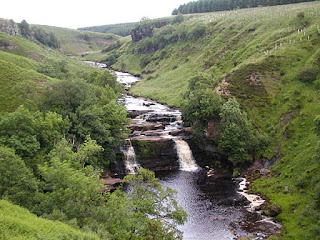River Irt, Cumbria
River Irthing, Cumbria
Rivers Irt and Irthing With Roman Roads
Several times in the past I have discussed the possible presence in Cumbria of bear river-names and even the presence of a bear cult. The departure point for my final post on this subject remains the identification of the River Irthing on Hadrian's Wall (where we find the Banna and Camboglanna Roman forts) as the 'Little Bear'. This place-name etymology was proposed by Dr. Andrew Breeze (see https://mistshadows.blogspot.com/2019/02/the-bear-river-of-birdoswald-banna-and.html).
[Brythonic place-name expert Alan James has recently reminded me of the following: "While Breeze's -inn was a diminutive suffix, -in wasn't; it was simply a name-forming suffix. The two were indistinguishable to OE speakers, and soon fell together in Brittonic. So Irthing needn't necessarily be 'little' anything - it might rather have marked it as the Irt, i.e. the Bear and not the Little Bear."]
If we accept the 6th century Arthur's place of origin as the Irthing Valley, we can connect his name (actually from Roman/Latin Artorius) with Cumbric arth, 'bear', and thus suggest that the name was chosen for a royal son precisely because of the name of the river. James also commented on the name Arthwys, found as the father of Ceidio (my candidate for Arthur) in the Welsh genealogies for the Men of the North:
"Arthwys is likely a tribal name, *Artenses, 'the people of the Arth'. There does seem to have been some cult of a bear-deity in the Wall area, possibly connected with the Irt and Irthing river-names."
There are, of course, problems with deriving both Irt and Irthing from a Cumbric arth or an arth with a specific suffix. But these are not at all insurmountable. What follows is a rather technical explanation of how this could have come about. Some of James' statements are interspersed with my questions (in italics).
Could the Irt be a petrified (or fossilized) form of arth? OR could it be the river of the bears (plural eirth instead of singular arth)?
Yes, both the genitive singular and nom/acc plural forms of art- had /i:/, causing final i-affection which changes the preceding /a/ to /ei/. That change was dated by Jackson to late 5th - early 6th cts, shortly before the final, inflexional syllables were elided. For example, Welsh Dineirth could be a petrified Brittonic genitive, ‘Fort of the Bear’. However, if the name post-dates the shift to Neo-Brittonic (after c. mid sixth century), then it would be ‘Fort of the Bears’. We also find Dinerth many times as an early spelling for this Welsh place-name.
In your mind, what language in the area, at the right time, could have caused to shift from E- to I-?
Pretty certainly Northumbrian OE. OE didn't have /ei/, I think that would normally have been adopted as /e:/, but perhaps the following /-rt/ would have favoured raising to /i:/
A NOTE ON THE DACIAN BEAR-GOD, ZALMOXIS:
When I mentioned to Alan James that the Dacians appear to have worshipped a bear-god, and that they were present for centuries as the garrison of the Banna Roman fort in the Irthing Valley, he responded thusly:
"I wouldn't have much problem with a bear-god cult catching on among locals who no doubt had plenty of contact (even through intermarriage) with the Dacians. I remain agnostic as to any connection with the Irthing river-name, though even if it wasn't originally connected with bears it might have been reinterpreted that way."
When I mentioned to Alan James that the Dacians appear to have worshipped a bear-god, and that they were present for centuries as the garrison of the Banna Roman fort in the Irthing Valley, he responded thusly:
"I wouldn't have much problem with a bear-god cult catching on among locals who no doubt had plenty of contact (even through intermarriage) with the Dacians. I remain agnostic as to any connection with the Irthing river-name, though even if it wasn't originally connected with bears it might have been reinterpreted that way."



No comments:
Post a Comment
Note: Only a member of this blog may post a comment.